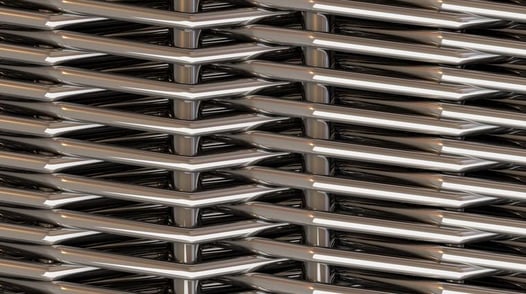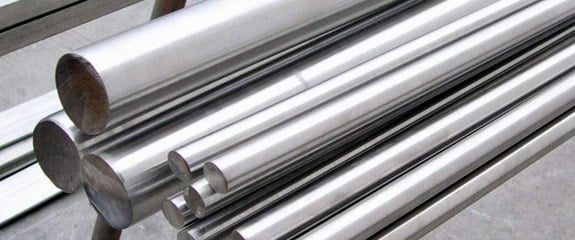347 vs 316 Stainless Steel: Weaving the Perfect Wire Mesh
Stainless steel is by far the most widely used alloy used to weave woven wire mesh. It offers the perfect balance of durability and cost-effectiveness, making it ideal for most applications.
But stainless steel itself is broken into categories, such as 300 series and 400 series stainless steel, each with a number of subcategories. This can make it extremely confusing when trying to identify which stainless steel you should be using.
347 and 316 stainless steel, for example, offer similar qualities but, at the same time, are beneficial to their own set of applications. That said, which stainless steel alloy should you be using?
W.S. Tyler has been a prominent supplier of woven wire mesh goods for over 150 years and has dealt with every alloy imaginable along the way. We strive to leverage this experience to help you design wire mesh solutions that deliver.
The following article was written to help shed some light on the difference between 347 and 316 stainless steel. You will learn:
- How 347 stainless steel is defined in the world of woven wire mesh
- The benefits of using 347 stainless steel woven wire mesh
- How 316 stainless steel is defined in the world of woven wire mesh
- The benefits of using 316 stainless steel woven wire mesh
- The difference between 347 stainless steel and 316 stainless steel

What Is 347 Stainless Steel?
347 stainless steel is an austenitic steel alloy known for its stability. It is comprised of carbon, manganese, chromium, phosphorus, silicon, niobium, nickel, and sulfur.
The inclusion of chromium as well as niobium makes 347 stainless steel one of the more stable 300-series stainless steel variants.
What Is 347 Stainless Steel Used For?
Typically, 347 stainless steel is reserved for applications that require specific corrosion-resistant thresholds. In fact, 347 stainless steel is primarily known for its ability to resist intergranular corrosion by combating carbide precipitation.
That said, the level of resistance to common forms of corrosion 347 stainless steel delivers is comparable to that of 304 stainless steel. At the same time, however, 347 can withstand greater stress loads than 304 stainless steel.
It should also be known that 347 stainless steel can be applied to applications that require your mesh to be welded. Because it is classified as an austenitic alloy, 347 stainless steel has superior weldability compared to other high alloys.
What Is 316 Stainless Steel?
In regards to weaving woven wire mesh, 316 stainless steel stands as the most used alloy in the 300 series stainless steel family. On a molecular level, it is comprised of nickel, molybdenum, chromium, and minimal traces of carbon.
The low presence of carbon places 316 stainless steel in the low-carbon alloy category.
What Is 316 Stainless Steel Used For?
The inclusion of nickel and chromium stabilizes 316 stainless steel, allowing it to provide superior corrosion resistance than its 304 counterpart. To that end, its reduced carbon levels further enhance its resistance to corrosion.
This, in turn, minimizes carbide precipitation build-up. For this reason, 316 stainless steel excels in applications that subject woven wire mesh to high moisture levels, as it is less likely to rust.
How Do 347 and 316 Stainless Steel Compare?
First and foremost, the niobium in 347 stainless steel makes it more resistant to high temperatures and oxidation than 316 stainless steel. This, in turn, will affect what welding processes you can apply to that alloy as well as how it will perform when used in high-heat applications such as exhaust systems in chemical processing plants.
That said, 316 stainless steel is much easier to weld as it contains less carbon. But because 347 contains niobium, it is more stable when being welded.
This helps it combat intergranular corrosion and sensitization more effectively than 316 stainless steel when welded.
Now, it should be noted that 347 stainless steel delivers superior mechanical characteristics than 316 stainless steel. This again makes 347 more appealing than 316 when heat resistance is desired.
To that end, because it contains much higher carbon levels than 316 stainless steel, 347 stainless steel is subject to scaling at higher temperatures.
Discover a Weave Type That Compliments the Alloy You Choose
347 and 316 stainless steel both fall into the 300-series family and are known for their stability. While 316 is a standard alloy that offers superior weldability, 347 offers superior corrosion resistance and mechanical strength.
Once you pinpoint a wire mesh alloy that can accommodate your process, the next step would be to identify a weave type to use. The weave type should be calculated as it will control how well particles, gases, and liquids pass.
For 150 years, W.S. Tyler has worked to learn how our customers’ processes work inside and out in an effort to help them identify the wire mesh specifications they need to stop worrying about the wire mesh they and afford more time to spend on other aspects of their operation.
Read the following article to get a better idea of the weave type you should be using to refine the way your wire mesh performs:
About Ronnie Brown
Ronnie is the Content Writer for W.S. Tyler and has four years of experience as a professional writer. He strives to expand his knowledge on all things particle analysis and woven wire mesh to leverage his exceptional writing and graphic design skills, creating a one-of-a-kind experience for customers.




